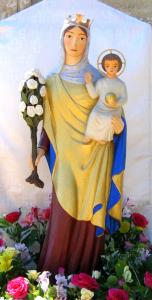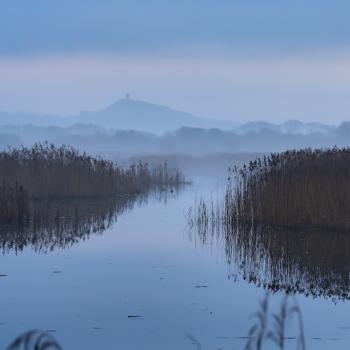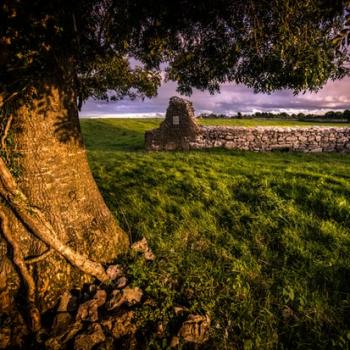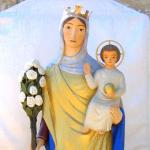The Cradle of Christianity in England
Glastonbury has been a sacred pilgrimage site for millennia and proclaimed as the spiritual heart of England. Glastonbury has been speculated as the cradle of Christianity in England, as a result of various intriguing myths. In particular, the reconstruction of the old church in Glastonbury Reading University | Glastonbury’s Old Church and various saints who may have walked upon this sacred land.
St. Joseph of Arimathea
At the heart of the myths surrounding Glastonbury is the early Christian story that the young Jesus once visited here. It’s possible that Joseph of Arimathea took Jesus on one of his many visits to England. This cannot be confirmed because nothing has been recorded during this period of Christ’s life. Joseph of Arimathea was a wealthy merchant who was related to Mother Mary. According to the Talmud, Joseph was the younger brother of Joachim, the father of Mary. William Blake referred to this possibility in his hymn Jerusalem:
And did those feet in ancient time
Walk upon England’s mountains green?
And was the holy Lamb of God
On England’s pleasant pastures seen?
Mining on the Mendip Hills probably began in the late Iron Age. It is believed that one of these mines was owned by Joseph of Arimathea. After the crucifixion of Jesus, local lore has it that Joseph of Arimathea, (who donated his own tomb to Jesus) came to Britain, bearing the Holy Grail.
When Joseph arrived at Glastonbury, it is said that he landed on Wearyall Hill, which was the main port of entry to the ancient isle at that time. He thrust his staff into the ground and rested. By morning, his staff had grown into an oriental thorn bush. Ever since it has been called the Glastonbury Thorn. In December a cutting is sent to the King for his Christmas dinner table. The tradition of taking a cutting from the holy thorn to send to the monarch dates back to the reign of King James I in the early 17th Century. The Glastonbury holy thorn is unusual because, unlike normal hawthorn trees, it flowers twice a year – once in winter and once in spring.
The Holy Grail chalice was the cup used by Christ at the Last Supper and later by Joseph to catch Christ’s blood at the crucifixion. Joseph buried the Holy Grail just below the Tor, at the entrance to the Underworld. Soon after, a spring, (the red spring at Chalice Well), flowed and the water that emerged brought eternal youth to anyone who drank it.
It is then told that Joseph of Arimathea with his twelve followers established the first monastery at Glastonbury and built the first wattle church. No evidence of this has been found, but it is compelling. In 1939 Frederick Bligh Bond made a reconstruction of how he thought the ‘Old Church’ would have appeared; as a round structure at the centre of a palisaded compound, surrounded by 12 smaller round structures or cells. This configuration is reminiscent of the configuration of dwellings in Iron Age village.
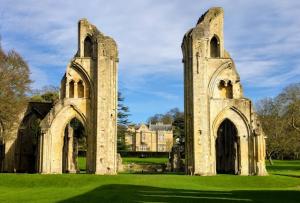
Picture: the ruins of Glastonbury Abbey
St. Patrick
The story of St. Patrick recounts that he was kidnapped in to slavery in Ireland, he managed to escape and returned to Britain. Here he was ordained and sent on a mission to Ireland by Pope Celestine.
The Glastonbury monks recorded that he returned once again to Britain, in a mid-13th century document called St. Patrick’s Charter. According to this account, Patrick became the leader of a group of hermits at Glastonbury after he returned from his mission in Ireland. He discovered an ancient ruined oratory after climbing through a dense wood. Some believe this oratory to be a chapel built by Joseph of Arimathea.
Researchers have uncovered that there could have been two Bishops named Patrick during the 5th century and one of them was interred in the abbey.
St. Brigid
There is a long-standing belief that St. Brigid visited Glastonbury, Somerset, in AD 488 in the footsteps of St. Patrick. She stayed for a few years in Beckery, where there was an oratory consecrated in honor of St. Mary Magdalene. From this, it is believed that a chapel in honor of St. Brigid was constructed. The area is now called St. Bride’s Mound and it would have been an island before the marsh was drained.
It was a place pilgrims who arrived from the west landed and kept vigil for a night before coming to Glastonbury.
St. Michael’s tower on the tor has a carving of St. Brigid milking a cow.
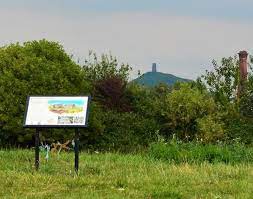
Picture: view from Bride’s Mound
